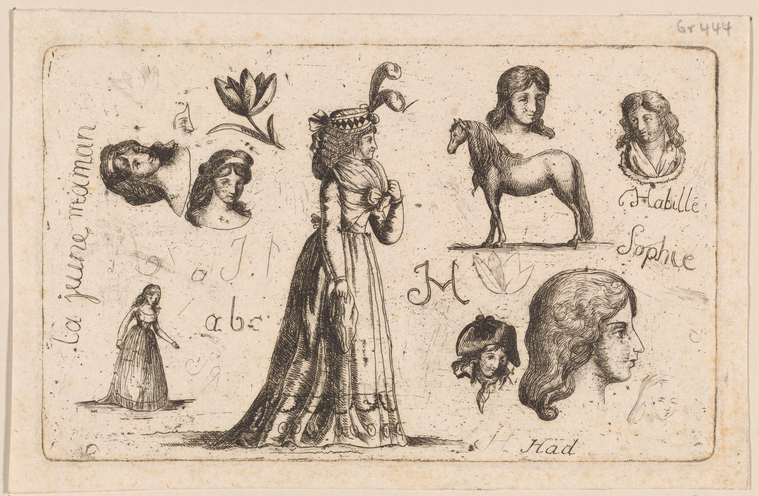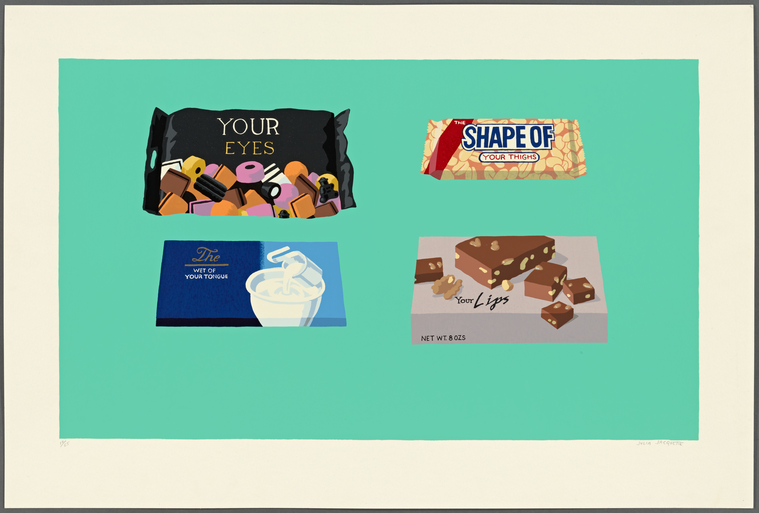Printing Women: Julia Jacquette
While the exhibition Printing Women focuses on Henrietta Louisa Koenen’s (1830–1881) collection of female printmakers from the 16th to 19th centuries, it is only appropriate to signal women’s continuing participation in the medium as well as the Library’s longstanding commitment to acquiring and exhibiting prints made by women from around the world. To complement this earlier history, therefore, I worked with the Library’s Digital Experience Team to display online a small sampling of works by contemporary printmakers in the Library’s collection. We began reaching out to artists, asking if we could display their work on the exhibition’s web page and digitize it for our digital collections. The majority were delighted to contribute, many also provided writings about their work and the exhibition. Throughout the exhibition’s run, I will choose and present a piece by one artist every other week on the exhibition’s web page. Additionally, I will produce a blog post about their work as well as about works in the exhibition, featuring their own words when possible.
For those who are interested in the long history of women’s involvement with the medium of print, there is much more to explore within the Library’s deep and varied holdings. The exhibition features only a smattering of Koenen’s collection (which numbers over 500 prints of which only a little over 80 are shown in the exhibition). In addition, the Print Collection not only owns large numbers of additional prints from the period in which Koenen collected, but also many, many more works from the 20th- and 21st-century.
The first blog post is by Julia Jacquette about her work Four Sweets, 1997.

There’s an etching included in “Printing Women” that has particular resonance for me: the sheet of sketches and studies of horses, names, and ladies faces and clothes. It seems utterly familiar, the 1800’s version of the sheet of drawings secretly made in one’s notebook while in math class in high school. As a kid, I myself made numerous drawings that were visual collections of what I desired, or spaces where I wanted to be (for example, the back-to-school clothes I coveted, or the cross section of an imagined department store). Although this print was most probably more about practicing etching technique, for me it has the feeling of making an inventory of what the artist herself finds lovely and important to her.
The practice of collecting and creating multiples started early for me. My elementary school cohorts and I bought and traded “Wacky Packs”: a series of stickers sold in packets with a piece of bubble gum, a la baseball cards. They depicted full color visual parodies of the packaging popular products - everything from Cabbage Patch Dolls to Ajax soap. I still think of them as some of the most hilarious and visually subversive imagery I can think of. When I was about eight years old I used one of the early photo copy machines in our public library to create issues of my own fashion magazine, “Kittypolitan” (a nod to Cosmopolitan magazine).
As a budding fine artist I spent much time with my aunt, the painter Yvonne Jacquette, who always had a print project going on simultaneous to her paintings in progress. For me it was unquestioned that I would be creating prints and other multiples as part of my practice.
My print Four Sweets was created In in 1995 and was published by Margarete Roeder and Karen McCready, and was printed by Jean-Yves Noblet. I realize now that that the fact that this artwork is made up modules (Four Sweets consists of four separate prints) goes back to those childhood collectables. That artwork, and many I have done before and since, was an attempt to use a visual language to talk about longing (sexual and every other kind of longing), a feeling of inadequacy, and admit to my own entrancement with the visual language of the popular media.
Four Sweets was only my second published print, but I’ve worked with many publishers and printers since then. My multiples have also included an unlimited edition of paper goods for the MoMA’s Café Etc., and a bandana made for the MacDowell Colony artists’ residency’s centennial.
Read E-Books with SimplyE
 With your library card, it's easier than ever to choose from more than 300,000 e-books on SimplyE, The New York Public Library's free e-reader app. Gain access to digital resources for all ages, including e-books, audiobooks, databases, and more.
With your library card, it's easier than ever to choose from more than 300,000 e-books on SimplyE, The New York Public Library's free e-reader app. Gain access to digital resources for all ages, including e-books, audiobooks, databases, and more.
If you don’t have an NYPL library card, New York State residents can apply for a digital card online or through SimplyE (available on the App Store or Google Play).
Need more help? Read our guide to using SimplyE.
